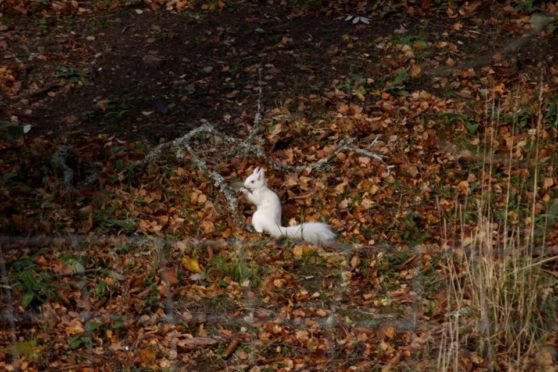Wildlife conservationists have reported a sighting of a pale and mysterious creature roaming the woods of Aberdeenshire.
But despite the ghoulish time of year, the Scottish Wildlife Trust has moved to reassure residents it is nothing supernatural but a rare white, red squirrel.
The experts, working in Royal Deeside, have been able to identify it as a red squirrel, rather than one of its grey cousins, because of the hairy tufts on its ears.
But they still do not know what has caused its unusual colouring and so are now aiming to get a closer look.
Conservation officer with the trust’s Saving Scotland’s Red Squirrels (SSRS) project in the north-east, Dr Gwen Maggs, said: “We know it is a red rather than a grey squirrel as photographs show it has the hairy ear tufts that are absent in greys.
“We will set up some remote cameras to try and get better pictures, with a clear view of its eyes. Then we can tell for certain if it’s an albino – as true albinos have red eyes.
“In any event, this is a rare and exciting discovery.
“Dare I say it’s the icing on the cake of the success of our recovery project here in the north-east which has seen red squirrels returning to areas, including parts of Aberdeen City, after a gap of more than 30 years.”
Coordinator of the North East Scotland Biodiversity Partnership, Alex Stuart, added: “Partly white animals, like sparrows, crows, blackbirds and even hedgehogs do appear from time to time, but these are not true albinos.
“Sightings like this really demonstrate the value of keeping your eyes and ears open.
“There is a lot of other amazing wildlife to be seen and heard out there as well as white, red squirrels.”
The two groups are encouraging residents and tourist in the north-east to report squirrel sightings to SSRS.
These can be logged at scottishsquirrels.org.uk, while the North East Scotland Biological Record Centre welcomes all sightings of any wildlife submitted via nesbrec.org.uk or by post.
Nesbrec, covering Aberdeen, Aberdeenshire, Moray and the Cairngorms National Park, currently has records of more than 1.5 million species.
